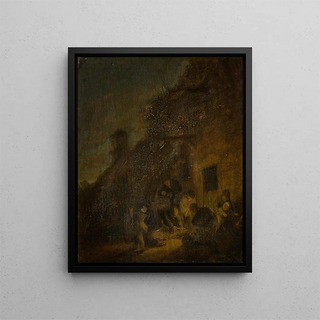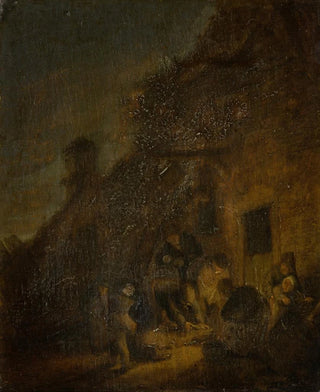Art print Abattre un cochon à la lueur d'une torche - Adriaen van Ostade | Art print


View from behind

Frame (optional)
In the vibrant world of 17th-century Flemish painting, the art print "Slaughtering a pig by torchlight" by Adriaen van Ostade stands out for its striking realism and intimate atmosphere. This painting, capturing a moment of rural life, immerses the viewer in a scene that is both raw and convivial. Through the flickering torchlight, the artist manages to create a warm, almost familiar ambiance, where everyday reality blends with a certain poetry. Although the scene's subject matter is brutal, it evokes universal themes such as community, tradition, and the cycle of life.
Style and uniqueness of the work
Van Ostade's style is characterized by a masterful use of light and shadow, a technique known as chiaroscuro. In "Slaughtering a pig by torchlight," he exploits this technique to highlight the textures of the characters and surrounding objects. The meticulous details of the faces, clothing, and even the pig's flesh are rendered with precision that testifies to the artist's exceptional talent. The composition is carefully thought out, with each element finding its place in a harmonious balance. The torch, as a source of light, becomes the focal point of the scene, illuminating the faces of the protagonists while casting shadows that enhance the drama and intensity of the moment. This painting perfectly illustrates Van Ostade's ability to capture peasant life with rare authenticity, while adding an almost narrative dimension to his work.
The artist and his influence
Adriaen van Ostade, born in 1610 in Haarlem, is one of the undisputed masters of genre painting. A pupil of Frans Hals, he developed a style that is uniquely his own, marked by a sincere depiction of everyday life of the common people. His works, often populated by peasants, tavern keepers, and artisans, reflect attentive observation and empathy for his subjects. Van Ostade influenced many artists, both through his technical approach and his ability to tell stories through his compositions. His impact on Dutch painting is undeniable, and "Slaughtering a pig by torchlight" fits within this lineage of works that question the human condition while celebrating daily life. The richness of details and the depth of emotion conveyed by his characters continue to inspire generations of artists who followed him.
An exceptional wall decoration signed by Artem Legrand

Matte finish

View from behind

Frame (optional)
In the vibrant world of 17th-century Flemish painting, the art print "Slaughtering a pig by torchlight" by Adriaen van Ostade stands out for its striking realism and intimate atmosphere. This painting, capturing a moment of rural life, immerses the viewer in a scene that is both raw and convivial. Through the flickering torchlight, the artist manages to create a warm, almost familiar ambiance, where everyday reality blends with a certain poetry. Although the scene's subject matter is brutal, it evokes universal themes such as community, tradition, and the cycle of life.
Style and uniqueness of the work
Van Ostade's style is characterized by a masterful use of light and shadow, a technique known as chiaroscuro. In "Slaughtering a pig by torchlight," he exploits this technique to highlight the textures of the characters and surrounding objects. The meticulous details of the faces, clothing, and even the pig's flesh are rendered with precision that testifies to the artist's exceptional talent. The composition is carefully thought out, with each element finding its place in a harmonious balance. The torch, as a source of light, becomes the focal point of the scene, illuminating the faces of the protagonists while casting shadows that enhance the drama and intensity of the moment. This painting perfectly illustrates Van Ostade's ability to capture peasant life with rare authenticity, while adding an almost narrative dimension to his work.
The artist and his influence
Adriaen van Ostade, born in 1610 in Haarlem, is one of the undisputed masters of genre painting. A pupil of Frans Hals, he developed a style that is uniquely his own, marked by a sincere depiction of everyday life of the common people. His works, often populated by peasants, tavern keepers, and artisans, reflect attentive observation and empathy for his subjects. Van Ostade influenced many artists, both through his technical approach and his ability to tell stories through his compositions. His impact on Dutch painting is undeniable, and "Slaughtering a pig by torchlight" fits within this lineage of works that question the human condition while celebrating daily life. The richness of details and the depth of emotion conveyed by his characters continue to inspire generations of artists who followed him.
An exceptional wall decoration signed by Artem Legrand
12,34 €






